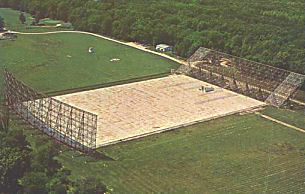© 2006 All Rights Reserved. Do not distribute or repurpose this work without written permission from the copyright holder(s).
Printed from https://danginteresting.com/the-wow-signal/?date=2024-08-15
It’s no rare occurrence in science fiction: The introverted researcher working the graveyard shift at a SETI radio observatory jumps out of his seat in surprise when the red light blinks on the control panel. “We’re getting a signal!” he shouts into a phone as needles dance across paper chart recorders, and scientists rapidly converge on the scene. At some point someone yells, “Get me the President!” at the person whose job it is to get presidents.
On August 15th, 1977, such a signal was received at the Big Ear radio observatory in Ohio, though the ensuing drama was considerably more subdued. The volunteer who spotted the pattern on the paper logs circled the data and wrote “Wow!” in the margin. The radio telescope was observing space as part of the Search for Extra-Terrestrial Intelligence (SETI) program, and it was the most compelling signal the receiver had recorded in its fourteen years of operation. It was powerful enough to push the Big Ear’s monitoring device off the charts.
The signal came from the direction of the constellation Sagittarius, and lasted seventy-two seconds at about 1420.456 MHz before it faded away. The volunteer who found and circled the data in the paper printout was Jerry Ehman, who was amazed at the signal’s intensity and what a narrow range of frequencies it appeared in. Seventy-two seconds also happened to be the exact length of time it would take for the Earth to rotate the Big Ear through a signal from space. He did some analysis of the data, and by all indications this powerful, narrowband radio signal was from outside of our solar system. But was it sent by an advanced civilization?

Curiously, the signal was picked up by only one of the scope’s two detectors. When the second detector covered the same patch of sky three minutes later, it heard nothing. This indicated either the unlikely possibility that the first beam had detected something that wasn’t there, or that the source of the signal had been shut off or redirected in the intervening time. The observatory researchers trained their massive scope on that part of the sky for a full month, watching closely for a repeat of the mysterious signal. Nothing interesting was observed during those thirty days, yet scientists were at a loss for an explanation of the original event. Planning to return to that patch of sky periodically, the Big Ear continued its broader purpose.
Several times over the next twenty years, longtime SETI researcher Robert Gray and his colleague Kevin B. Marvel arranged for further scans of that region of space. They managed to obtain some time on the META array at the Oak Ridge Observatory in Massachusetts, and the extremely sensitive Very Large Array (VLA) in New Mexico, which is made up of twenty-seven 25-meter radio dishes. They detected some extremely faint sources of radio emissions in the infamous patch of sky, but nothing like that of the “Wow!” signal. However their findings did essentially disprove the only working theory as to the cause of the original event: “interstellar scintillation.” It was thought that perhaps some weaker radio signal from space had been temporarily focused on the Big Ear in a way similar to stars twinkling… but the VLA is sensitive enough that it would have detected such a source, and it did not.

The Big Ear maintained its periodic scan of that part of space for almost forty years, and never again came across such a compelling signal. It was dismantled in 1998 to make way for a golf course.
“Wow” remains the strongest and clearest signal ever received from an unknown source in space, as well as the most fascinating and unexplainable. The signal’s original discoverer Jerry Ehman doesn’t care to speculate on its source, and he remains scientifically skeptical. “Even if it were intelligent beings sending a signal,” he said in an interview, “they’d do it far more than once. We should have seen it again when we looked for it 50 times.”
Perhaps. But consider that when humankind used the Arecibo radio telescope to send a message out into space in 1974, it was only sent once.
Update August 2024: New research suggests that the Wow signal may have been a natural phenomenon, a “sudden brightening from stimulated emission of the hydrogen line due to a strong transient radiation source, such as a magnetar flare or a soft gamma repeater.”
© 2006 All Rights Reserved. Do not distribute or repurpose this work without written permission from the copyright holder(s).
Printed from https://danginteresting.com/the-wow-signal/?date=2024-08-15
Since you enjoyed our work enough to print it out, and read it clear to the end, would you consider donating a few dollars at https://danginteresting.com/donate ?